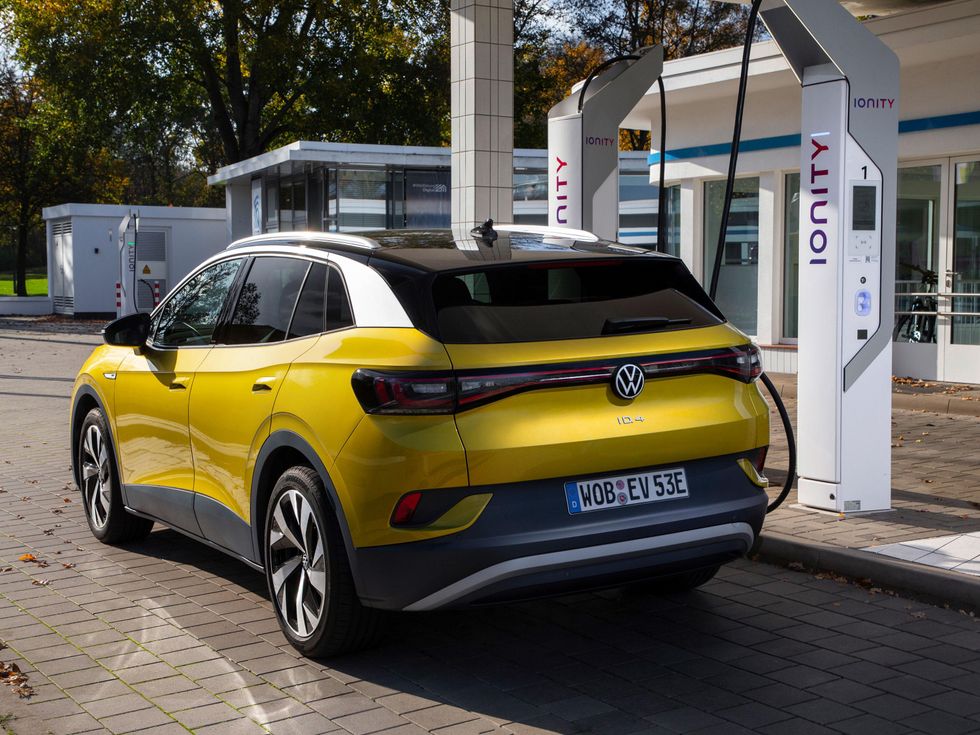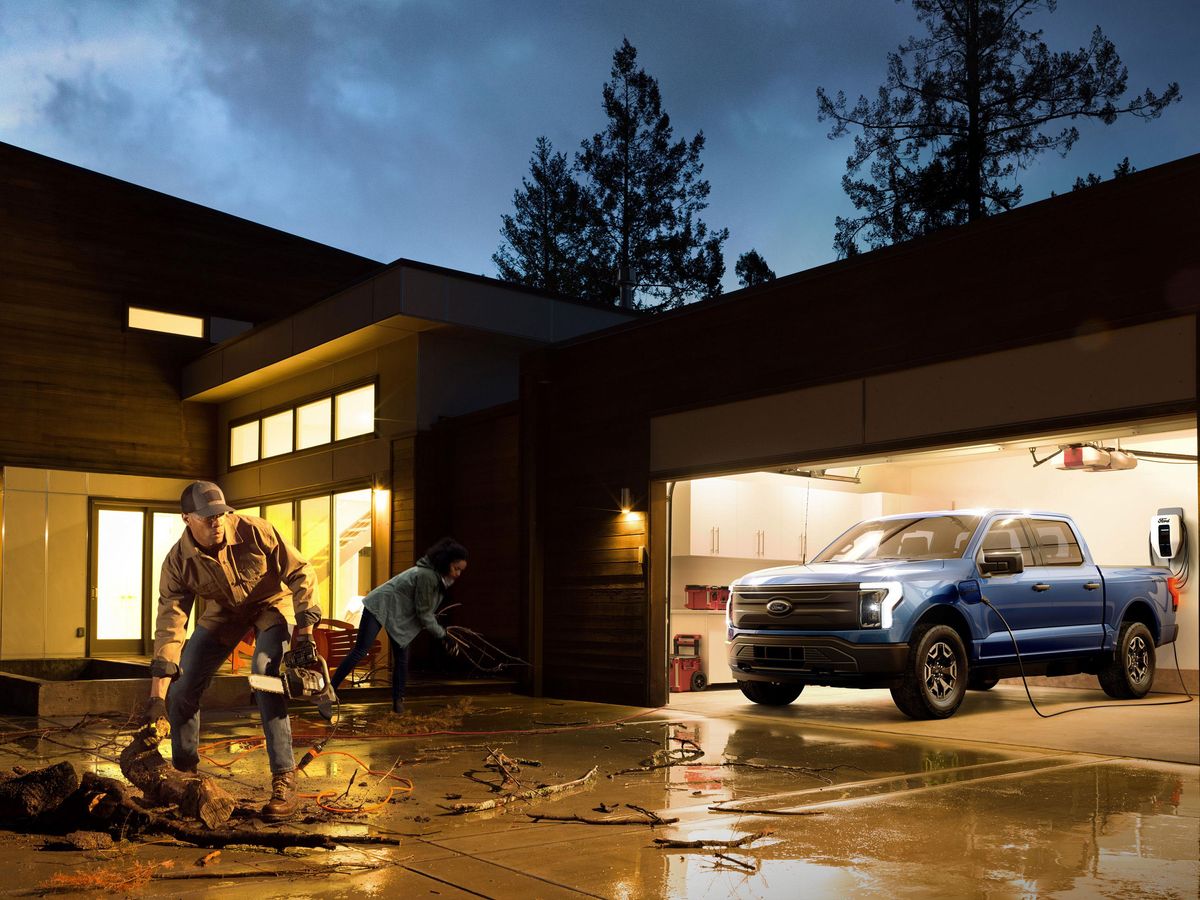Starting this year, thousands of battery-powered electric-drive Volkswagen vehicles capable of both loading and off-loading current—bidirectional charging, as the industry calls it—have been rolling off production lines in eastern Germany.
And in the last two weeks, one of the largest utility companies in the United States, Pacific Gas & Electric Company, announced plans to work with General Motors in experiments with their bidirectional-charging technologies. Ford, another auto-industry titan, has also made bidirectional charging a selling point of its F-150 Lightning electric truck, reportedly slated to roll off the lines this year.
The general principle for bidirectional charging is that EVs can either feed power from a charged vehicle back into the house (vehicle-to-home or V2H) or interact with the electric grid itself (vehicle-to-grid or V2G). These V2H/V2G-enabled vehicles offer some three to 10 days powering the fridge and lights in case the power goes down. A side benefit could be plugging in appliances to the car while camping rough.
After years (and depending on how you count it, decades) of work, momentum may be close to pushing bidirectional-charging technologies into the mainstream. It’s not quite ready for the mainstream yet, though. The ratio of marketing and expectations to the intake of real-world information is still steep. And plenty of technology remains left to be worked out, including the complex supporting infrastructure, business models, and various forms of electric plugs and chargers, alongside their sometimes confounding range of pin configurations.
Ford’s brawny new entrant into the mix is its new F-150 Lightning, out this year with an estimated 482 kilometers (300 miles) of range on a full charge with a 454-kilogram (1,000-pound) payload. The pickup boasts 563 horsepower, does 0 to 60 in 4 seconds, and wields 1,050 newton meters (775 pound-feet) of torque.
According to Ford, a driver can roll this beast into a garage mounted with the $1,310 80-amp Ford Charge Station Pro, where its AC pins can deliver a full overnight charge at a 19-kilowatt output to the truck’s 98-kilowatt-hour (131 kWh if you have the extended extra-big-range) lithium-ion battery. In case of power outage at home, the DC pins in the charger can send juice back into the house, keeping the lights on. According to Ford, that translates to three days for an average 30 kilowatt-per-hour-per-day house with the extended-range Lightning battery, or as long as 10 days when used with a home solar-power system that is equipped with a transfer switch that disconnects the house from the grid.
America’s largest panel producer, Sunrun, of California, has teamed up with Ford to offer solar roof panels integrated into the transfer switch setup in sync with Ford’s Intelligent Backup Power installation. Tesla, right now the world’s best-selling manufacturer of electric vehicles, is already marketing an integrated setup involving solar panels and a large wall-mounted battery as a kind of nascent virtual utility in Germany and in the United Kingdom.
For its part, General Motors—the power behind Chevrolet and GMC—is now set to work with San Francisco–based Pacific Gas & Electric to test forthcoming GM electric vehicles as on-demand power sources for homes. No word yet on which EVs will take part. (GM produces the Chevy Volt and GMC Hummer EV and is preparing its 2023 launch of the Silverado EV.) The GM tests reportedly start in a few months at PG&E’s applied technology services lab in San Ramon, Calif., with the aim to try out GM EVs first in pilots and then in larger customer-home trials by the end of 2022, utility spokesman Ari Vanrenen says. PG&E’s testing with Ford starts with five customer homes receiving their vehicles this April—for test purposes ideally in high-fire-threat districts that could be affected by an event causing public-safety-related power shutoff.
One of the first uses of bidirectional charging followed the Great East Japan Tōhoku earthquake, tsunami, and nuclear power plant accident at Fukushima. Battery-electric Nissan Leafs in the region were able to deliver spot backup power between the rolling blackouts in those days. But while bidirectional backup from EVs promises lights on when the power’s out, the utility testing will be done to ensure safe interconnection. The electric truck and battery is considered a generation of technology similar to rooftop solar and home energy-battery storage, and in PG&E’s service area (which is northern California) Lightning owners with bidirectional charging to the home will need to apply for approval to connect the charger to the grid.

The bidirectional networked future won’t necessarily arrive with an overnight flick of the switch, however. Market watchers and researchers alike are wary of potential compatibility and standards issues, and consumer uptake is unpredictable.
From the owner’s perspective there will be concerns in bidirectional use about battery drain and wear and tear, says Philip Krein, of the Grainger Center for Electric Machinery and Electromechanics at the University of Illinois in Urbana-Champaign. And he’s skeptical about the cost factor in home bidirectional charge points. “Most charging, except for those relatively few long-range trips, can be supported with a conventional 120-volt or 220-volt outlet,” he argues. And that’s much cheaper than a new $1,300 kit.
Peter Andersen, a distributed energy resources researcher in Denmark, also wonders about how charge points will be deployed and used in more crowded urban centers—places where few people have garages and it's harder to get around in a big pickup truck—as well as the way in which network hardware will be developed. “There’s still a lack of interoperability,” he says. “So you essentially need to buy everything from the same provider.” Just as there is an Apple ecosystem, so with home and EV-battery systems you could wind up with a Ford setup, a Tesla setup, or a VW setup. Not so independent.
Even so, world events are putting wind in the sails for backup power. On 16 March there was another earthquake near Fukushima—luckily a much milder one, though still knocking out power to 2 million people. The Ukraine war is playing havoc with energy pricing and market stability. Cleaner power—and energy sourcing—is a more pressing concern. “Maybe it's not out of necessity that you don't have access to the grid,” Andersen says. “Maybe it can also be that you want to pursue some energy autonomy.”
- Solving the Electric Vehicle Charging Conundrum - IEEE Spectrum ›
- Ford's 2021 F-150 Pickup Is a Mobile Power Station - IEEE Spectrum ›
- This Dutch City Is Road-Testing Vehicle-to-Grid Tech - IEEE Spectrum ›
- The EV Transition Explained - IEEE Spectrum ›
- False Starts: The Story of Vehicle-to-Grid Power - IEEE Spectrum ›
Michael Dumiak is a Berlin-based writer and reporter covering science and culture and a longtime contributor to IEEE Spectrum. For Spectrum, he has covered digital models of ailing hearts in Belgrade, reported on technology from Minsk and shale energy from the Estonian-Russian border, explored cryonics in Saarland, and followed the controversial phaseout of incandescent lightbulbs in Berlin. He is author and editor of Woods and the Sea: Estonian Design and the Virtual Frontier.



